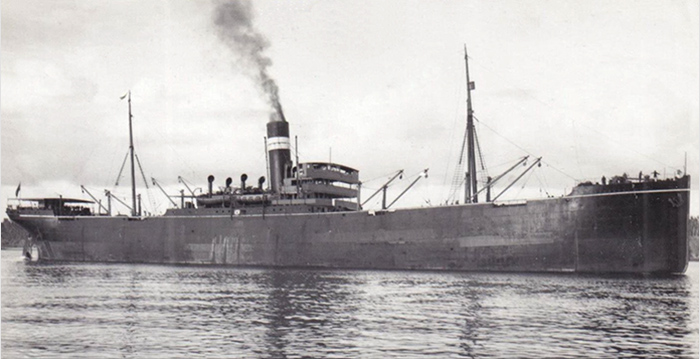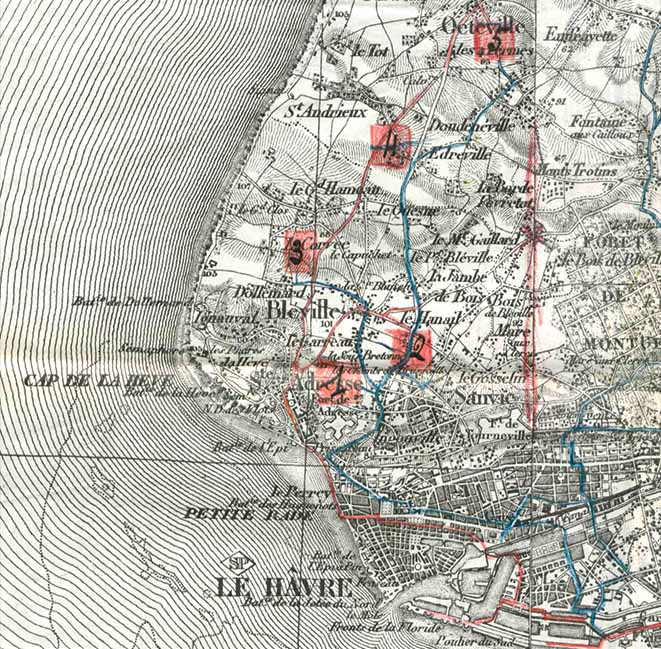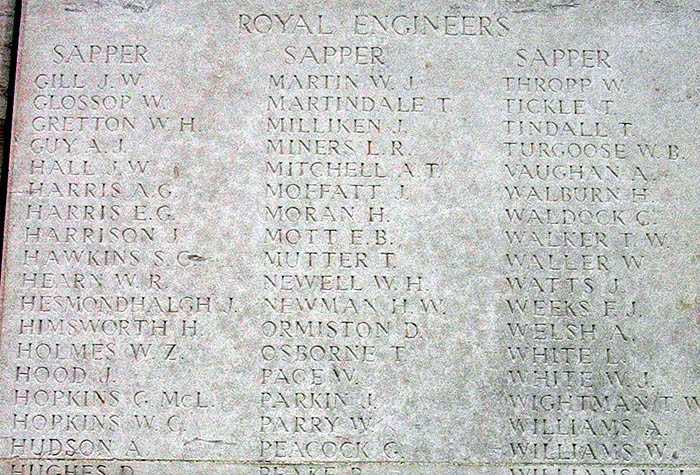Arthur Hudson was born in Derby in 1889, the sixth child of John and Frances Hudson. He was baptised at St Chad’s Church on 15th January 1890. He grew up in Normanton, Derby, living at 44 Church Street during his infant years, but by 1901 the family were living at 41 Newdigate Street, and by 1907 they had moved to 1 Barley Row.
In April 1911, Arthur was working as a bricklayer’s labourer but by 1915 he had joined the 73rd Field Company of the Royal Engineers. His regiment number was 42228.
In the evening of 8th July 1915, Arthur boarded a train at Swindon and together with his regiment travelled the 40 minute journey to Southampton. Arriving at 2 a.m. on the 9th, the men were accommodated in a shed. By noon all the regiment’s vehicles and horses had been loaded, and the men boarded the SS Chyebassa, bound for Le Havre, France.
 SS Chyebassa
SS Chyebassa
Arthur arrived in France on 10th July 1915. The company began disembarking at 7 a.m. and by 11:30 a.m. all men, vehicles, horses, and equipment had been unloaded. 73rd Field Company R.E. comprised of 6 officers, 222 men of other ranks, and 81 horses. The men marched five miles north to rest camp number 5 at Octeville-sur-Mer where the company stayed for one day, awaiting orders.
 Location of rest camps 1 to 5 and the routes to them from Le Havre
Location of rest camps 1 to 5 and the routes to them from Le Havre
The role of the Field Company was to provide technical skill and know-how in support of fighting units. 73rd Field Company R. E. was attached to the 15th (Scottish) Division.
On 12th July at 2 p.m., Arthur and his company left the rest camp and boarded a train at Le Havre. Leaving at 6:59 p.m., they travelled north overnight and arrived at Audruicq at 11:15 a.m. After some difficulty in unloading pontoon wagons, the company marched the short distance to a place referred to as ‘Bertham’ where they billeted.
At Bertham, the company spent 14th July overhauling stores, route marching, practicing with searchlights, and exercising the horses. The following day, Arthur marched south-east from 7 a.m. until 2:15 p.m. to Arques, where the company billeted. The war diary notes that ‘the march was rather trying as the men’s boots had not been worn in properly’.
Two more days of marching followed. The company left Arques at 8 a.m. on 16th July travelling 14 miles south, arriving at Saint-Hilaire-Cottes at 1 p.m. On the 17th they left Saint-Hilaire-Cottes at 9 a.m. with orders to march to Bruay-la-Buissière, but two miles outside of the town they were directed north to Bois des Dames, arriving 12:30 p.m. It was windy with heavy showers during march, and the company spent the afternoon constructing shelters.
For the next week, Arthur and his company were improving shelters and communications, cutting brushwood, pickets and poles, stacking stakes, improving roads in Bois des Dames, and loading lorries for the front.
The 73rd Field Company of the Royal Engineers was divided into four sections numbered 1 to 4. It is not known which section Arthur was in, but on 25th July, 1 and 2 Sections left Bois des Dames at 11 a.m. for work in the trenches, returning on the 27th when they were replaced by 3 and 4 Sections, who returned on the 29th. After spending the following day loading eighteen lorries with ‘picket and handle stuff’, at 7 p.m. the whole company left Bois des Dames and marched four miles east to Nœux-les-Mines, arriving at 9:40 p.m., where they billeted.
Arthur was based at Nœux-les-Mines for much of August, where the company constructed shelters and a workshop. From 6th to 13th August, the whole company were engaged with ‘night work on the 6th emplacement’. On the 16th, number 4 Section moved into billets 2½ miles west at Mazingarbe, where they constructed trenches and wire entanglements, while the rest of the company worked during the night on 6 inch gun emplacements. After improving watering arrangements for the horses, the men built a hut for IV Corps at Vaudricourt, an hour march north-west from Nœux-les-Mines. On 29th August, number 2 Section was ‘bomb making’ at Mazingarbe, and by 31st August the whole company had moved there.
At Mazingarbe, Arthur’s Company was engaged with ‘making up bombs’, building dug-outs, improving the water supply to the trenches which had been interrupted by shelling, constructing bridges over trenches, building a bomb store, making a tramway, and repairing damage to trenches caused by the enemy. Much of this work was done at night.
On 22nd September, orders for an attack were communicated to officers, and on the 24th the company ‘moved into trenches ready for the assault’. During the night, the trenches were shelled intermittently but there were no casualties among 73rd Field Company.
In the evening of 25th September, Arthur took part in the assault of the German trenches at Loos. All the men were instructed to wear ‘smoke helmets on the head rolled up’, which were to be lowered before entering any German line. These khaki-coloured British smoke hoods were made of canvas and had a rectangular eyepiece. They were treated with chlorine-absorbing chemicals to provide protection against poison gas. Ahead of the actual assault, the British discharged gas for 12 minutes, followed by 8 minutes of smoke, another 12 minutes of gas, and finally another 8 minutes of smoke. The smoke was intended to conceal infantry during the assault and the chlorine gas, used by the British for the first time, was a means of compensating for a relatively lightweight artillery. The assault itself took place after these 40 minutes had passed, at 6:30 a.m.
During the assault, number 1 and 2 Sections followed about 100 yards behind the main fighting units of the Black Watch and Seaforths until ‘they came to the barbed wire in front of Loos. Here 2nd Lt. Ryan and 11 men were killed or wounded’. Here number 1 and 2 Sections separated; 1 Section ‘worked through Loos with the infantry’ while 2 Section ‘proceeded by the outskirts of Loos to a front...but they came under such heavy fire that they had to lie down...a part of the Section remained behind all night to help hold the line’.
Meanwhile, number 3 and 4 Sections waited in rear of the 10th Battalion of the Gordon Highlanders until they advanced. ‘During this wait number 4 Section were ordered to bridge a trench over the Lens road. During this operation...10 NCO’s and men were either killed or wounded.’
Casualties of the 73rd Field Company of the Royal Engineers from this assault were 16 men killed, 26 wounded, and 10 missing. For a company whose role it was to improve and repair infrastructure and provide technical support to fighting units, the disappointment is reflected in the last sentence of the war disary for this day, which reads ‘The company acted as infantry practically the whole time.’
On 26th September 1915, Arthur was reported as wounded and missing. He was 26 years old and had been in France for only 11 weeks.
Sapper Arthur Hudson is remembered on the Loos Memorial.
 Panel 4 and 5, Loos Memorial, France
Panel 4 and 5, Loos Memorial, France
Arthur is also remembered on the headstone of his parents.
 ‘Also of their beloved son Sapper Arthur Hudson, ·RE· wounded and missing at Loos September 1915, aged 26 years.’
‘Also of their beloved son Sapper Arthur Hudson, ·RE· wounded and missing at Loos September 1915, aged 26 years.’
Arthur was posthumously awarded the 1914-15 Star, British War Medal, and the Victory Medal. It is not known whether his medals survive, but Arthur’s name, service number, rank, and unit was impressed on the rim of the British and Victory medals, and on the back of the 1914-15 Star.
 The 1914-15 Star, British War Medal, and the Victory Medal
The 1914-15 Star, British War Medal, and the Victory Medal
Arthur Hudson was my great-granduncle.